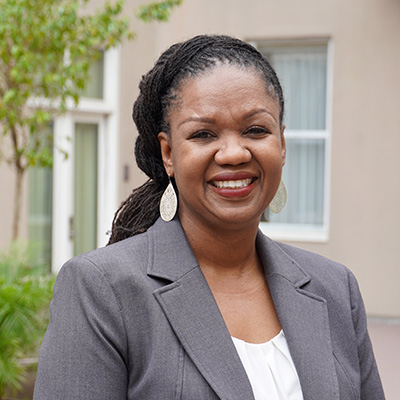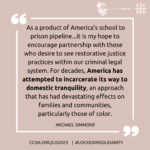Equal Justice USA today is a much different organization than it was more than 20 years ago at our founding. Then we were focused sharply on ending the death penalty through state campaigns, and we’ve succeeded on that front.
As important as those wins are, what we learned from those campaigns about all survivors of violence — and the unhealed trauma they hold — is equally critical. So under the leadership of our founder, Shari Silberstein, we deepened and expanded our mission. We built a vision for justice reimagined.
That vision is anchored by a new approach to justice that delivers healing, safety, and accountability that repairs for everyone. This vision continued to drive the harm reduction of the current system while we began building alternative strategies that centered healing as a way to prevent violence.
Restorative justice became a cornerstone of those strategies, something we admired and believed in, but it was a practice we didn’t have a direct connection to when we built the vision. But everything changed over the past year.
What is Restorative Justice?
Restorative justice is a framework and process that starts with the needs of people who have been harmed, brings the impacted community together, and facilitates true accountability — acknowledgment, repair, and change that ensures harm will not be repeated.
To be clear, restorative justice is not new. It is a “philosophy and set of practices, rooted in indigenous teachings, that emphasize our interconnection by repairing relationships when harm occurs while proactively building and maintaining relationships to prevent future harm.”
The Restorative Justice Project (RJP) had been helping communities and grassroots organizations build their own restorative justice practices for years as part of Impact Justice. In 2023, Impact Justice’s leaders felt like it was time for the RJP to spin off, and all of us at EJUSA were thrilled that they have joined our team.
Why Restorative Justice?
I spent nearly 15 years trying to fix the current justice system both from inside and just beyond, at another nonprofit. I had already lived through its failings; seen the system’s sole reliance on punishment and how that devastates Black communities; witnessed how the system dehumanizes us, divides us into good and bad; and, most painfully, struggled as a violence survivor whose needs would never be met by the justice system.
EJUSA’s vision for a new system spoke to me, and restorative justice played a huge role. As a Christian, I know the power of God’s redemptive love for us all and how His love for us—and the love He calls us to have for one another—is rooted in relationship. Restorative practices allow us to model God’s love, which does not change even when we make mistakes or hurt others.
What Does Restorative Justice Look Like?

Here at EJUSA, the RJP focuses on supporting communities that work with young people using a model called Restorative Community Conferencing. For example, the team partners with the Youth & Arts Self-Empowerment Project in Philadelphia, whose healing justice restorative justice program works with young people diverted from the prosecutor’s office.
One case still resonates with the team. A group of young people physically attacked and robbed a woman at a train station. Healing justice facilitators worked separately with the person harmed and one of the boys involved. They sought to understand what the person harmed — also a mother of a small child — needed to heal while also ensuring that the boy was able to understand and work toward accountability.
After months of discussions, the healing justice facilitators held the community conference that included the person harmed, the boy who caused harm, his mother, and, importantly, other community members who had survived violence. After the person harmed shared how deeply she’d been impacted by the attack, the boy shared an accountability letter. Together, they came up with a plan that saw the boy volunteering with the Charles Foundation, an organization that supports people in healing from violence, while also working to provide restitution to the young mother. Upon completion of his plan, which culminated in a celebration with all conference participants, he decided to continue working with community activists responding to violence. This is just one example that can be achieved when we model God’s love and prioritize relationships.
Ninety percent of restorative justice participants report being satisfied by the process. That number far eclipses the satisfaction of those who relied on the criminal justice system — with its roots in slavery, white supremacy, and racial control and terror — and its sole focus on punishment.
Restorative justice is gaining newfound momentum because of its promise to heal and address the things that people truly need in the wake of harm.

About Jamila Hodge
Jami joined Equal Justice USA in 2021, bringing more than 15 years of criminal justice experience as a prosecutor, policy advisor, and technical assistance provider. Her goal is to establish EJUSA as a leader in building solutions to violence outside of the criminal legal system by demonstrating the impact of EJUSA’s work and the power of its vision for a system that heals rather than harms, and by expanding its reach throughout the country.





